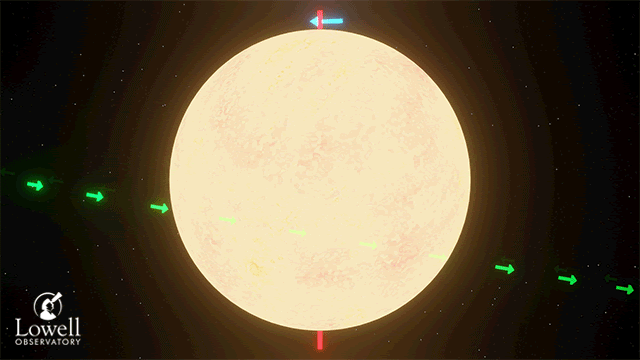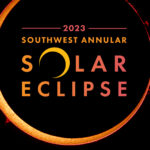
This artist’s impression shows the super-Earth 55 Cancri e in front of its parent star. Photo: NASA/ESA
Press Release: Study Reveals Secrets of Scorching Hot Super-Earth
Flagstaff, AZ. – A new study suggests that interactions between the scorching hot planet 55 Cancri e (abbreviated 55 Cnc e) and its parent star forced the planet to a remarkably tighter orbit, with 55 Cnc e speeding around the star startlingly fast. Such planets are unlike any in our solar system and studying them can help scientists better understand how planets form and move over time, as well as determine how common Earth-like environments are in the universe.
55 Cancri is a binary star system in Cancer containing the star 55 Cancri A (also known as Copernicus) and a red dwarf. Five planets orbit Copernicus, including 55 Cnc e, which is also classified as a super-Earth—an exoplanet that is larger than Earth but smaller than Neptune.

So much of a planet’s environment is determined by its orbit around its star. 55 Cnc e orbits Copernicus in just 18 hours and is one of the closest planets to its star. Because of this proximity to the star, 55 Cnc e is super hot and likely has oceans of lava. One puzzle that astronomers are trying to solve is how 55 Cnc e got so close to Copernicus; planets can’t form this close to their star because the temperatures are simply too hot. Studying their orbital history provides clues into the planet formation process.
As Copernicus rotates, half of the star is moving toward us (blue shifted), and the other half is moving away (red shifted). That means the light from half the star is a bit bluer, and the other half is slightly redder (and the space in the middle is unshifted). Astronomers can track 55 Cnc e’s orbit by observing when it transits Copernicus, measuring when it’s blocking light from the redder side, the bluer side, and the unaltered midsection.
The resulting difference in the starlight, however, is almost immeasurably small. Teams had tried before but couldn’t accurately determine the planet’s orbital path. The breakthrough came with the EXtreme PREcision Spectrometer (EXPRES), a Yale University-built instrument used in conjunction with Lowell Observatory’s Lowell Discovery Telescope (LDT) in Arizona.
Team member Dr. Joe Llama of Lowell Observatory says, “With instrumentation like EXPRES and telescopes like LDT we are now able to characterize these fascinating exoplanetary systems.”
The EXPRES measurements represent some of the most precise data on this tiny, hot exoplanet. Previous research suggests that the nearby orbit of the red dwarf resulted in the misalignment of the planets relative to Copernicus. In the new study, the researchers suggest that as 55 Cnc e approached Copernicus, the star’s gravity became increasingly dominant. Because Copernicus is spinning, the centrifugal force caused its midsection to bulge outward slightly and its top and bottom to flatten. That asymmetry affected the gravity felt by 55 Cnc e, pulling the planet into alignment with the star’s thicker equator.
Research team member Dr. Vedad Kunovac of Lowell Observatory says, “This result really gives us one of the first constraints of this kind on how ultra-short-period planets evolve and how they end up so close to a star.”
Project lead Dr. Lily Zhao, a research fellow at the Flatiron Institute’s Center for Computational Astrophysics (CCA), and her colleagues now plan to study other planetary systems. “We’re hoping to find planetary systems similar to ours,” Zhao says, “and to better understand the systems that we do know about.”
More Posts by Kevin Schindler, Lowell Historian
- PRESS RELEASE: Lowell Observatory Hosting Events for April 8 Total Solar Eclipse
 Lowell Observatory Hosting Events for April 8 Total Solar Eclipse Lowell Observatory is hosting two public events for the eclipse—one along the path of totality in Waco, Texas, and the other at the observatory’s home base in Flagstaff, Arizona, where the Sun will be partially eclipsed (68%). Flagstaff, AZ – The April 8 total solar eclipse is… Read more: PRESS RELEASE: Lowell Observatory Hosting Events for April 8 Total Solar Eclipse
Lowell Observatory Hosting Events for April 8 Total Solar Eclipse Lowell Observatory is hosting two public events for the eclipse—one along the path of totality in Waco, Texas, and the other at the observatory’s home base in Flagstaff, Arizona, where the Sun will be partially eclipsed (68%). Flagstaff, AZ – The April 8 total solar eclipse is… Read more: PRESS RELEASE: Lowell Observatory Hosting Events for April 8 Total Solar Eclipse - Press Release: LOWELL OBSERVATORY & GRAND CANYON CONSERVANCY PARTNER IN LIVESTREAM EVENT
 November 2, 2023 LOWELL OBSERVATORY AND GRAND CANYON CONSERVANCY PARTNER IN LIVESTREAM EVENT: NATIVE CONSTELLATION STORYTELLING FOR WINTER SKIES [Flagstaff; Grand Canyon, Arizona] – Lowell Observatory is proud to announce a unique and culturally enriching livestream event on November 15 in collaboration with Grand Canyon Conservancy. “Native Constellation Storytelling for Winter Skies” will be hosted by Lowell Observatory’s Public Information… Read more: Press Release: LOWELL OBSERVATORY & GRAND CANYON CONSERVANCY PARTNER IN LIVESTREAM EVENT
November 2, 2023 LOWELL OBSERVATORY AND GRAND CANYON CONSERVANCY PARTNER IN LIVESTREAM EVENT: NATIVE CONSTELLATION STORYTELLING FOR WINTER SKIES [Flagstaff; Grand Canyon, Arizona] – Lowell Observatory is proud to announce a unique and culturally enriching livestream event on November 15 in collaboration with Grand Canyon Conservancy. “Native Constellation Storytelling for Winter Skies” will be hosted by Lowell Observatory’s Public Information… Read more: Press Release: LOWELL OBSERVATORY & GRAND CANYON CONSERVANCY PARTNER IN LIVESTREAM EVENT - Celestial Alert: Jupiter at Opposition
 CELESTIAL ALERT October 25, 2023 JUPITER AT OPPOSITION [OCTOBER 25, 2023] On November 2, Jupiter will be in opposition, meaning it will be at its biggest and brightest of the year. Lowell Observatory invites guests to admire the “King of Planets,” the largest planet in our solar system, through its suite of state-of-the-art public… Read more: Celestial Alert: Jupiter at Opposition
CELESTIAL ALERT October 25, 2023 JUPITER AT OPPOSITION [OCTOBER 25, 2023] On November 2, Jupiter will be in opposition, meaning it will be at its biggest and brightest of the year. Lowell Observatory invites guests to admire the “King of Planets,” the largest planet in our solar system, through its suite of state-of-the-art public… Read more: Celestial Alert: Jupiter at Opposition - PRESS RELEASE: LOWELL OBSERVATORY CELEBRATES THE ANNULAR SOLAR ECLIPSE ON OCT 14
 LOWELL OBSERVATORY CELEBRATES THE ANNULAR SOLAR ECLIPSE ON OCTOBER 14 WITH “RING OF FIRE” ECLIPSE PARTY Solar telescopes, expanded hours of operation, eclipse programming, and refreshments for purchase will be available with all general admission passes on October 14 for the “Ring of Fire” Annular Eclipse, with a partial view of about 85% annularity from… Read more: PRESS RELEASE: LOWELL OBSERVATORY CELEBRATES THE ANNULAR SOLAR ECLIPSE ON OCT 14
LOWELL OBSERVATORY CELEBRATES THE ANNULAR SOLAR ECLIPSE ON OCTOBER 14 WITH “RING OF FIRE” ECLIPSE PARTY Solar telescopes, expanded hours of operation, eclipse programming, and refreshments for purchase will be available with all general admission passes on October 14 for the “Ring of Fire” Annular Eclipse, with a partial view of about 85% annularity from… Read more: PRESS RELEASE: LOWELL OBSERVATORY CELEBRATES THE ANNULAR SOLAR ECLIPSE ON OCT 14 - We Got Time on the Hubble Space Telescope – Now What?
 We Got Time on the Hubble Space Telescope – Now What? For astronomers to “get time on” the Hubble Space Telescope, they first need to write a proposal and then hope that it gets approved. But there is a big step between this approval and actually getting data. While the James Webb Space Telescope… Read more: We Got Time on the Hubble Space Telescope – Now What?
We Got Time on the Hubble Space Telescope – Now What? For astronomers to “get time on” the Hubble Space Telescope, they first need to write a proposal and then hope that it gets approved. But there is a big step between this approval and actually getting data. While the James Webb Space Telescope… Read more: We Got Time on the Hubble Space Telescope – Now What?